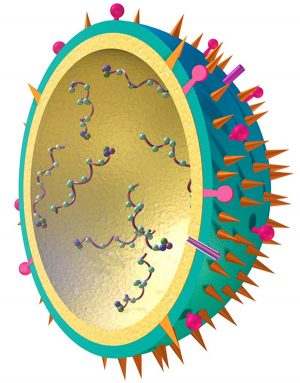Flu in the air
Germs tiny enough to pass through surgical masks may cause half of all cases

It’s easy to catch the flu. Just breathe.
Tiny, germ-laden particles in the air may cause half or more of all cases of the respiratory infection. And that is a surprise, scientists now report. Until now, researchers thought large particles — the type that can’t stay airborne long after being expelled by a cough or sneeze — spread most cases of influenza.
Tiny particles that can float in the air for hours to days are known as aerosols. Researchers knew that germy aerosols might spread flu. They just thought such tiny particles almost never did. Recognizing this mistake is important. Public health officials can’t easily prevent infections if they don’t know how most people pick up a disease.
Benjamin Cowling at the University of Hong Kong and his coworkers studied the spread of flu in 782 families. All lived in Bangkok, Thailand, or in Hong Kong and had at least one family member who became sick between 2008 and 2011.
Prior to these illnesses, some of those families had received soap and directions on how to keep their hands clean. Some also had received surgical masks. These masks prevent large airborne particles (like those emitted during a sneeze) from getting into the wearer’s nose or mouth. They may also prevent the spread of drops that spray from a wearer’s mouth or nose during a cough or sneeze. But the masks don’t block the far tinier aerosols. And some of those can host flu viruses.
Over time, Cowling’s group tallied which of the volunteers they were monitoring came down with the flu. Many had been wearing masks and washing hands. This all but rules out larger mucus or moisture droplets as the source of the flu. What’s left are those airborne aerosols. The scientists share their findings June 4 in Nature Communications.
In Hong Kong, aerosols appear to have caused at least 33 in every 100 cases of flu — and maybe as many as 92 in every 100 cases. In Bangkok, aerosols caused between 55 and 98 of every 100 cases.
That’s a wide range of numbers, says Donald Milton at the University of Maryland in College Park. An environmental scientist, he did not work on the new study. But, he says, what it really shows is that for flu’s spread, “you can’t rule out aerosols.” In fact, they can continue to spawn infections long after a sick person was coughing or simply present in a room.
Power Words
aerosol A tiny particle released in a fine spray or formed when gases or moisture trap tiny bits of solid matter. Some may remain airborne for weeks until they are destroyed, glom onto a surface with which they collide or are washed from the air by rain.
particle A tiny portion of matter.
flu, or influenza A highly contagious viral infection of the respiratory passages causing fever and severe aching. It often occurs as an epidemic.
epidemic A widespread occurrence of an infectious disease in a community at a particular time.







